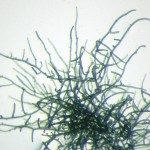Link to Pubmed [PMID] – 31461939
Toxins (Basel). 2019 Aug 27;11(9). pii: E498
Cyanobacteria are an ancient lineage of slow-growing photosynthetic bacteria and a prolific source of natural products with diverse chemical structures and potent biological activities and toxicities. The chemical identification of these compounds remains a major bottleneck. Strategies that can prioritize the most prolific strains and novel compounds are of great interest. Here, we combine chemical analysis and genomics to investigate the chemodiversity of secondary metabolites based on their pattern of distribution within some cyanobacteria. being a cyanobacterial genus known to form blooms worldwide and to produce a broad spectrum of toxins and other bioactive compounds, we applied this combined approach on four closely related strains of . The chemical diversity of the metabolites produced by the four strains was evaluated using an untargeted metabolomics strategy with high-resolution LC-MS. Metabolite profiles were correlated with the potential of metabolite production identified by genomics for the different strains. Although, the strains present a global similarity in terms of a biosynthetic cluster gene for microcystin, aeruginosin, and prenylagaramide for example, we found remarkable strain-specific chemodiversity. Only few of the chemical features were common to the four studied strains. Additionally, the MS/MS data were analyzed using Global Natural Products Social Molecular Networking (GNPS) to identify molecular families of the same biosynthetic origin. In conclusion, we depict an efficient, integrative strategy for elucidating the chemical diversity of a given genus and link the data obtained from analytical chemistry to biosynthetic genes of cyanobacteria.

